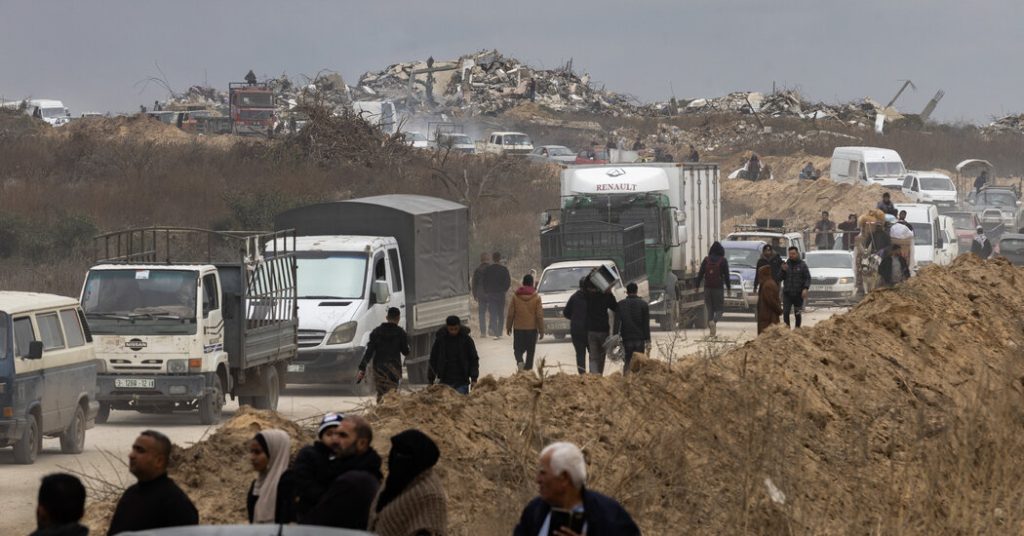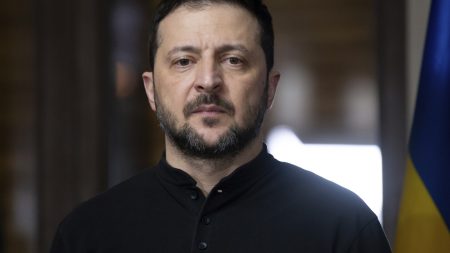Israel’s Withdrawal from the Netzarim Corridor: A Key Step in the Gaza Cease-Fire
Israel’s military completed its withdrawal from the Netzarim Corridor in Gaza on Sunday, marking a significant milestone in the fragile cease-fire agreement with Hamas. The withdrawal, required under the initial 42-day phase of the truce, allows hundreds of thousands of Palestinians to return to their homes in northern Gaza. This step is crucial for advancing the next stage of the agreement, which could potentially lead to a full Israeli military withdrawal from Gaza and the end of the war.
The Netzarim Corridor, a contentious strip of land that has long divided the Gaza Strip, was once a major flashpoint in the conflict. Israeli troops had patrolled the area to prevent Palestinian movement, especially after ordering a mass evacuation of northern Gaza in the early days of the war. The military’s departure, confirmed by both Israeli officials and Hamas, reflects the tenuous progress made under the cease-fire. However, the situation remains volatile, with foreign security contractors now responsible for inspecting vehicles in the corridor to prevent weapons transfers. The Gaza Interior Ministry has urged residents to exercise caution and adhere to movement restrictions for their safety.
Despite the withdrawal, Israel’s military presence in Gaza is not entirely gone. Troops remain in a small area near the Egyptian border in southern Gaza and along the Israeli border, where a buffer zone has been established. This limited presence underscores the complexity of the conflict and the challenges of achieving a lasting peace.
Hostage Release and the Human Toll of the Conflict
The release of three Israeli hostages by Hamas on Saturday has brought renewed attention to the human cost of the conflict. The hostages, who appeared gaunt and malnourished upon their release, sparked widespread concern in Israel, with many drawing comparisons to Holocaust survivors. Their condition has intensified public pressure on Prime Minister Benjamin Netanyahu to secure the release of all remaining captives.
The families of those still held hostage, including Alon Ohel, have issued urgent appeals for their safe return. In a statement, Ohel’s family revealed that they had received their first confirmation of his survival in over 490 days, noting that he is being held in tunnels in Gaza alongside others recently freed. The statement pleaded with Israeli leaders to “take the necessary humanitarian steps to rescue Alon and the other victims from the hell they are experiencing.” The family also emphasized that “time is running out” and called for the second phase of the cease-fire deal to be expedited to bring all hostages home.
Netanyahu has faced criticism for his handling of the hostage crisis, with many accusing him of not acting quickly enough. In response, Netanyahu shifted blame to Hamas during an interview in Washington, where he met with the Trump administration. He claimed that Hamas, not Israel, was responsible for the deteriorating conditions of the hostages and expressed optimism that at least half a dozen more captives would be released by the end of next week.
International Reactions and the Challenges of Diplomacy
The Israeli delegation’s visit to Qatar over the weekend highlights the ongoing diplomatic efforts to navigate the cease-fire and secure the release of more hostages and prisoners. However, progress in the next phase of the truce, which could involve a full Israeli withdrawal from Gaza, faces significant hurdles. A contentious proposal by former U.S. President Donald Trump, who suggested that the U.S. could take over Gaza and transform it into the “Riviera of the Middle East” by relocating Palestinian residents, has drawn sharp criticism from Arab nations.
Saudi Arabia’s foreign ministry reiterated its rejection of the plan, emphasizing that no lasting peace can be achieved without the establishment of a sovereign Palestinian state. This stance reflects a long-standing diplomatic goal, though many officials and experts now consider it nearly impossible to realize. Meanwhile, Egypt has announced plans to host an emergency Arab summit in Cairo later this month to address the escalating tensions and “dangerous developments” in the Palestinian cause. The summit, coordinated with high-level officials across the Arab world and requested by Palestinian leaders, aims to unify the region’s response to the crisis.
Despite these efforts, the path forward remains fraught with challenges. Netanyahu’s meeting with his top security officials in the coming days will be critical in determining whether the cease-fire can advance to its next phase. Until then, the humanitarian toll of the conflict continues to mount, with no clear end in sight.
Continued Tensions and Violence
Even as Israeli troops withdrew from the Netzarim Corridor, violence persisted in other parts of Gaza and the West Bank. In eastern Gaza City, three people were killed and several others wounded by Israeli gunfire, according to Mahmoud Basal, a spokesman for Gaza’s civil defense agency. Basal warned residents to stay away from the Israeli border and military positions, citing ongoing dangers.
The Israeli military reported that its soldiers had fired warning shots at suspects in the northern Gaza Strip who were “a few hundred meters” away from them. While the military acknowledged hitting its targets, it did not provide details on casualties. In another incident, Israeli soldiers stationed near the Israeli border community of Kibbutz Nahal Oz shot at individuals breaching the perimeter fence. Matan Weitz, a spokesman for the kibbutz, reported increased military activity in the area, including tank and vehicle movements, following the shooting.
Israeli Defense Minister Israel Katz vowed “zero tolerance” for threats to soldiers or Israeli communities near the border, while Netanyahu addressed the incident in a speech to lawmakers, stating, “Nobody reaches the perimeter fence or enters it.”
In the West Bank, the Israeli military continued its raids and patrols, which it claims are aimed at rooting out militants before they can carry out attacks. However, these operations have resulted in civilian casualties, including the killing of a pregnant woman in the Nour al-Shams refugee camp in Tulkarm. The Israeli military has launched a criminal investigation into the incident, but tensions in the region remain high.
Pressure Mounts on Netanyahu Amid Ongoing Negotiations
The release of the three hostages has placed renewed pressure on Netanyahu to secure the freedom of all remaining captives and advance the second phase of the cease-fire deal. Netanyahu’s critics argue that his government has not acted with sufficient urgency to address the plight of the hostages, many of whom have been held for over a year.
Despite the presence of negotiators and mediators in Qatar, little progress is expected in the talks until Netanyahu convenes a meeting with his top security officials. Netanyahu, however, has sought to deflect criticism by blaming Hamas for the hostages’ conditions. In his interview with Fox News, he outlined Israel’s three war aims in Gaza: destroying Hamas’s military and governing capabilities, securing the release of all hostages, and ensuring that Gaza no longer poses a threat to Israel. Netanyahu expressed confidence in achieving all three objectives, predicting that additional hostages would be freed by the end of next week.
Nevertheless, the humanitarian concerns and political pressures continue to mount. The families of the captives have called for immediate action, and the Israeli public is growing increasingly impatient. As the conflict enters a critical phase, the ability of Netanyahu and his government to balance military objectives with humanitarian imperatives will be closely scrutinized.
The Humanitarian Crisis and the Uncertain Future
The humanitarian toll of the conflict is undeniable, with civilians on all sides bearing the brunt of the violence. The release of the three hostages, while a welcome development, has also highlighted the dire conditions faced by those still in captivity. Their gaunt appearances have shocked the Israeli public and reignited calls for urgent action to secure their release.
At the same time, the ongoing violence and military operations in Gaza and the West Bank continue to claim civilian lives and exacerbate the humanitarian crisis. The killing of a pregnant woman in Tulkarm and the wounding of others in Gaza City serve as stark reminders of the fragile situation on the ground.
As the region braces for the outcome of the Arab summit in Cairo and the next round of negotiations in Qatar, the path to a lasting peace remains fraught with challenges. The U.S. proposal to take over Gaza has further complicated the diplomatic landscape, with Arab nations rejecting the idea outright. For now, the focus remains on securing the release of all hostages and advancing the cease-fire to its next phase.
The situation in Gaza and the West Bank is a stark reminder of the human cost of conflict and the urgent need for a resolution that addresses the root causes of the violence. Until then, the people of Gaza and Israel will continue to live in uncertainty, hoping for a future where peace prevails.












